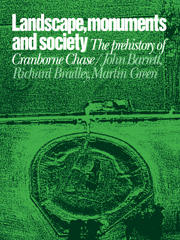1 - Time and place
Published online by Cambridge University Press: 07 May 2010
Summary
The archaeology of social reproduction
The main themes of our title, Landscape, monuments and society, often appear to be specific areas of archaeological interest. Monuments, for instance, are analysed in terms of their form and structural history, and the landscape provides a context for the distribution of monuments, revealing their spatial organisation and ecological setting. But what of society? If anything, society appears as the ghost in the machine, whose archaeologically verifiable existence is still contested. Let us therefore look at the relationship between society, the landscape and the monument.
Since the work of Gordon Childe, archaeologists have tended to treat ‘society’ as a system of institutions which are mapped by their material remains. Cultural archaeologists defined the social realm as a relatively closed set of shared beliefs. It was the acceptance of those beliefs which established cohesion between a society's members and the practical application of belief systems which produced regular patterns of material association (Childe 1956). The application of this rather straightforward idea has led to the chronological and geographical ordering of artefacts and monuments. Such ordering has appeared to reflect the nature, history and extent of a given belief system; and the categorisation and mapping of archaeological material in these terms remains part of the conceptual framework of British archaeology.
By now there have been numerous criticisms of such an approach to archaeology. One of the more sustained critiques has been developed by Renfrew (1977). He notes that the definition of cultural types has depended upon norms, arbitrarily drawn from rich assemblages of material.
- Type
- Chapter
- Information
- Landscape, Monuments and SocietyThe Prehistory of Cranborne Chase, pp. 6 - 22Publisher: Cambridge University PressPrint publication year: 1991
- 2
- Cited by



